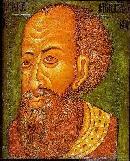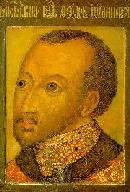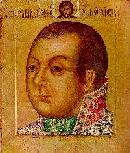




A parsuna (derived from the Latin word persona) is a type of portrait painting that developed in Russia in the late sixteenth century. It appeared, in a sense, as a transition between traditional icon painting and the more Westernized, "realistic" portrait. Characterized by an inexperienced naturalism, and yet retaining the one-dimensional style of icons, parsunas were created as memorials of contemporary secular figures. The appearance of parsunas coincided with the decline of traditional icon painting and was followed by a more complete acceptance of Western European style during the eighteenth century. Some of the best-known surviving parsunas (shown above in the order they are listed) are those of Ivan the Terrible (late 16th century), his son, Fiodor Ioannovich (late 16th century), and Prince Mikhail Vasilievich Skopin-Shuiskii (17th century). [B.B. and C.B.]
[Source: David and Tamara Talbot Rice.]
